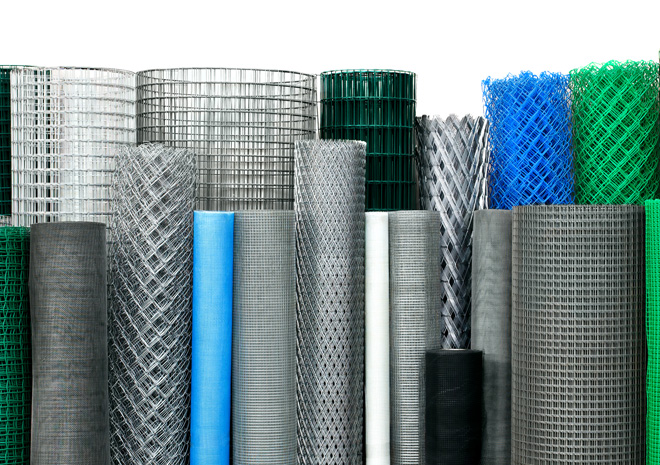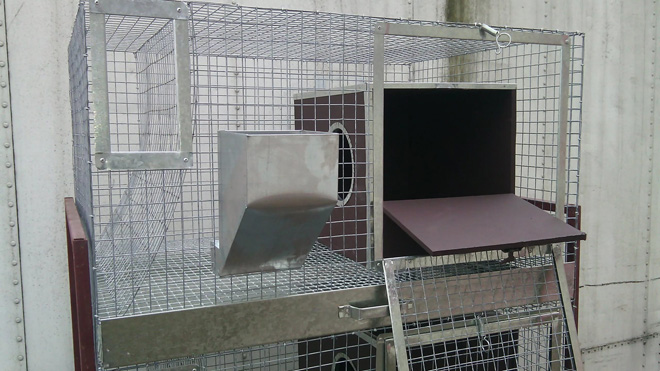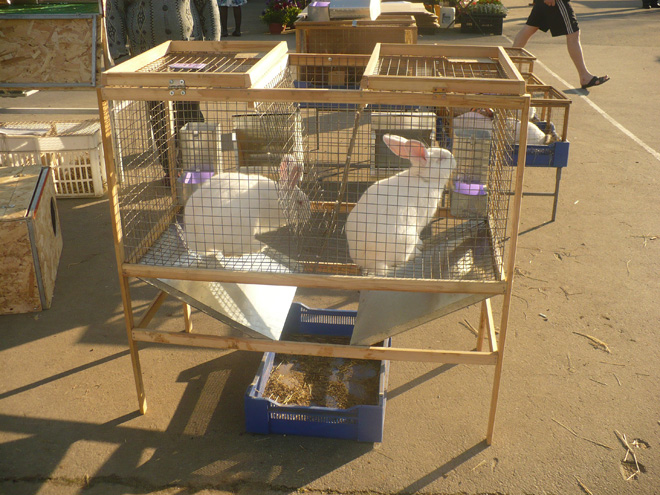From the habitat of rabbits depend on their health, fecundity, weight set, frame quality. Therefore, they need a convenient secure house. Cells from the grid for rabbits are the perfect option. They are easy to operate, provide good ventilation and safe. You can make a mesh cell yourself by using tips offered in this article.
This type of cell provides excellent ventilation and easy to operate.
Types of grid
Many break their heads by wondering what the grid is best suited to rabbits. The grid used in the construction of the poultry houses is unsuitable, as it is not strong enough to withstand the weight of an adult animal. The usual metal mesh quickly degrees, which is fraught with injuries, infection of the pads on the beast of the animal. Aluminum mesh is too soft for rabbit cells, over time it is deformed and breaks down the design.
Specialists advise using a welded metal grid with hot galvania. This material has a high, compared to other types, strength, is reliably protected from corrosion by the protective layer. Advantages of galvanized welded grid:
- strength;
- durability;
- animal safety;
- easy to operate;
- affordable price.
You can buy it in any construction store or on the market. Presented in the form of rolls or sheets. A welded galvanized grid differs from other species with characteristic swaps in welding places.
Choosing a grid, you should pay attention to the correctness of the shape of the cells. Any curvature indicates a low material quality, as well as a possible damage to the protective layer.
Dimensions of cells and diameter of rods
From what part of the structure the grid will be used, the diameter of its rods, the sizes of the cells will be dependent.
For the walls and the upper part, a mesh is suitable with a ponds of 2 mm thick, the material is needed more durable (3-4 mm).
To prevent the possibility of dislocation and fractures of the limbs, you should install a mesh with a square-shaped cells with a size of 20x20 mm.
Often, the roof is used as a feeder with hay, in this case they choose a grid with rectangular cells 25x120 mm.
The side panels are better made from the grid with square cells with a size of 25x25 mm.

For different parts of the cell, various types of grids are used.
Types of design
To assemble cells for rabbits from the grid with their own hands, first of all you need to decide on the place of animal content. This will depend on the design of the house. There are two types of mesh cells:
- the cell intended for the indoor content is a frameless design made entirely from the metal grid installed on the subheads;
- street - frame construction with a roof or covered with a canopy. It is made using a wooden or metal base, with partial walls of the walls.
Deciding with the type of design, the drawing of the future housing should be made. The optimal sizes of the cells from the grid for rabbits to accommodate one individual:
- width - 800 mm;
- height - 440 mm;
- length - 1280 mm.
In the drawing it is necessary to take into account not only the sizes of the cell, but also the sub-project to which it will be installed. It is also important to indicate the location of the door, feeders for bulk feed, water pipes, drinkers, hay feeders.
If we are talking about a street cage, in the drawing you need to mark the size of the canopy or roof.
Materials
To make a cage with your own hands, you will need two types of mesh:
- with square cells 20 × 20 mm, rod diameter at least 4 mm;
- with rectangular cells of 25 × 50 mm, the rod diameter is at least 2 mm.
In addition to the grid, you need to stock:
- fasteners: brackets, rings;
- metal sheet for pallets;
- plywood sheet;
- wood timber for construction framework under the cage;
- nails or self-drawing;
- metal corners;
- edge of plastic or any other seal that will protect sharp cuts on the grid;
- roofing materials for canopy;
- lock on the door.
Tools that will be useful in the process:
- cutting mesh cutting;
- pliers;
- file to burn sharp cuts;
- roulette;
- screwdriver;
- saw;
- scissors for cutting a metal sheet in the manufacture of a pallet.

When designing it is important to take into account not only the cell itself, but also the backup on which it will be located.
Progress
Even if the mesh cells for rabbits are designed for the content of one individual, they need to be made in large: rabbits are movable animals, they need space. It should be clarified that the proposed design of the mesh cell is not suitable for the pancake, it is recommended to attach it to a separate design.
After all the measurements are made, you can start assembling.
- The rear and front walls make the same size, the same applies to the side details.
- If the design is frameless, the floor and the ceiling are also cut out the same size.
- Side parts fasten with rings with galvanized brackets.
- The bottom of the cell is strengthened with a bar, which is inserted every 40 cm.
- On the floor, the mesh is used only partially, the royaltics and a sleeping place are made from a solid board or wooden plates, so that during the frosts of the animal's paws did not go to the rods.
- Street dwelling needs insulation. The phaneer is cut according to the size of the sides and fasten with the help of canopy to the frame. Thus, in the cold, the walls will close the home, and during the heat it will be possible to operate.
- To make the cell fall out of the frame, from all sides, in addition to the front, retainers are set in the form of wooden corners.
- The box is fastened with a rack of such a length so that the floor of the cells is above the ground at least 1.2 m.
- The cage frame is made such a size so that the mesh design easily placed in it. A box is peeled from wooden bars, the fasteners are enhanced by metal corners.
- The floor of the cell is attached with an indent from the bottom to one cell. At the bottom of the front wall, the rod is cut. The resulting gap will serve a niche in which the pallet is inserted for litter. It can also be made with your own hands or get plastic. If the floor area is large, and the bottom is separated by amplifying bars, they make individual pallets for each section.
- If necessary, inside the cell is set by the septum from the same mesh or plywood. Fastening to the adjacent walls with fixing brackets, rings. In the process of manufacturing cells, sections in the mesh partition are aligned with a file, protect the edge so that the animal does not hurt about sharp edges.
- To make a pallet for rabbit cells yourself, you will need a galvanized iron leaf. The size should be larger than the bottom of the cell per distance equal to one and a half cells in length and width. The gaps are necessary for the formation of pallet side. Iron edges on each side are bend perpendicular to the plane in the form of a brush. The height of the curved edge from all sides should be less than the cell width, so that the pallet is inserted freely, put forward.
- Holes on the places of the future door are cut through the places of the future, feeders.
Slices on the grid are definitely aligned with a file to avoid injuries.

In cells do not use elements from plastics.
- For the manufacture of the door takes a mesh for rabbits cells. The height and width of the segment must exceed the dimensions of the doorway. Fasten the doors with two rings. The outdoor part is equipped with a casing.
- For street cell, the frame is covered with additional materials: plywood, slate. Then the upper part is made with gaps from all sides at least 40 mm.
- The final stage is to install feeders, water pipes and drinkers. Experts recommend to make them outdoor, it facilitates care and simplifies the feeding process.
Summary
Summing up, you should select several important points.
- Grid for rabbits is the most suitable material for making cells.
- For the manufacture of rabbit cells, you need to choose a welded galvanized grid.
- To avoid injuries, the floor grid is chosen with smaller cells, and the sections are aligned.
- You can not use plastic.
- Street cells outside insulating plywood.
Make a high-quality cage for rabbits, which will last long, simply, if you make your work and adhere to the presented recommendations.
